check engine Peugeot 207 CC 2012 Owner's Manual
[x] Cancel search | Manufacturer: PEUGEOT, Model Year: 2012, Model line: 207 CC, Model: Peugeot 207 CC 2012Pages: 224, PDF Size: 7.1 MB
Page 5 of 224
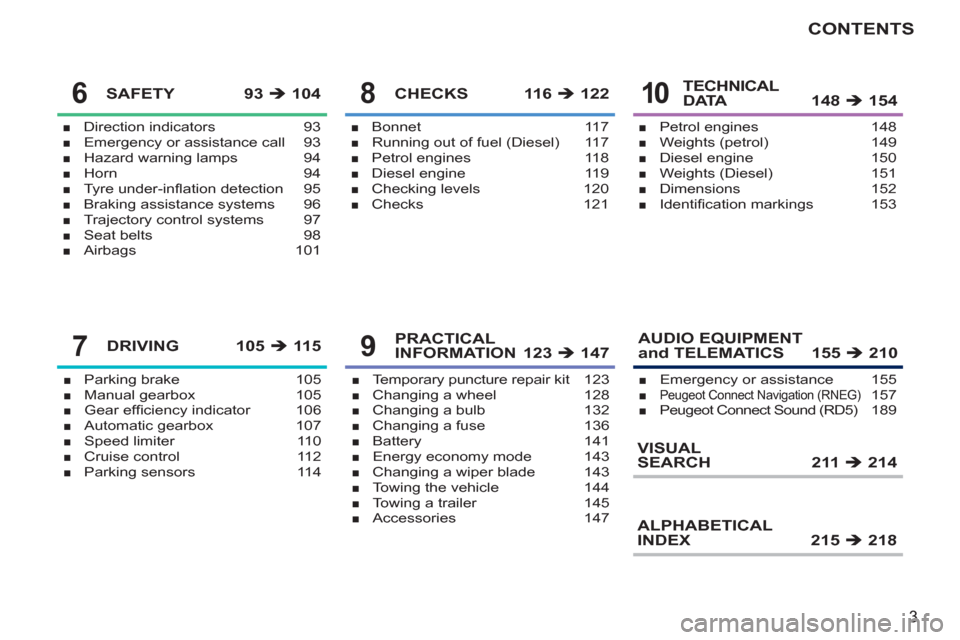
3
CONTENTS
Direction indicators 93
Emergency or assistance call 93
Hazard warning lamps 94
Horn 94
Tyre under-infl ation detection 95
Braking assistance systems 96
Trajectory control systems 97
Seat belts 98
Airbags 101■
■
■
■
■
■
■
■
■
SAFETY 93 �Π104
Parking brake 105
Manual gearbox 105
Gear effi ciency indicator 106
Automatic gearbox 107
Speed limiter 110
Cruise control 112
Parking sensors 114■
■
■
■
■
■
■
DRIVING 105 �Π11 5
Bonnet 117
Running out of fuel (Diesel) 117
Petrol engines 118
Diesel engine 119
Checking levels 120
Checks 121■
■
■
■
■
■
CHECKS 116 �Π122
Temporary puncture repair kit 123
Changing a wheel 128
Changing a bulb 132
Changing a fuse 136
Battery 141
Energy economy mode 143
Changing a wiper blade 143
Towing the vehicle 144
Towing a trailer 145
Accessories 147■
■
■
■
■
■
■
■
■
■
PRACTICAL
INFORMATION 123 �Π147
Petrol engines 148
Weights (petrol) 149
Diesel engine 150
Weights (Diesel) 151
Dimensions 152
Identifi cation markings 153■
■
■
■
■
■
TECHNICAL
D ATA 148 �Π154
AUDIO EQUIPMENT
and TELEMATICS 155 �Π210
Emergency or assistance 155Peugeot Connect Navigation (RNEG) 157
Peugeot Connect Sound (RD5) 189■
■
■
ALPHABETICAL
INDEX 215 �Π218
7
86
9
10
VISUAL
SEARCH 211 �Π214
Page 8 of 224

! !
i
6
FAMILIARISATION
OPENING
Retractable roof
When washing your vehicle:
- lock the vehicle,
- avoid spraying the upper part
of the windows,
- keep the end of the high-pres-
sure nozzle at least 1 metre
from the windows and door
seals.
After washing the vehicle or fol-
lowing rain, wait until the roof has
dried before opening it. The roof is operated under the
sole responsibility of the driver.
During operation of the roof, to
avoid the risk of injury, ensure that
no one is in the vicinity of the mov-
ing parts.
You are strongly advised not to op-
erate the roof in strong winds. It is preferable to operate the roof
with the engine running.
The roof can be operated at
speeds below 6 mph (10 km/h).
It is only possible to carry out the
operation twice with the engine off,
to avoid discharging the battery.
Preliminary conditions
�)
Switch on the ignition.
�)
Ensure that:
- the vehicle is not in energy economy
mode (refer to the corresponding
section),
- the battery voltage is suffi cient
(switching on of the indicator lamp
on the roof control),
- the roof fuse is in good condition (re-
fer to the corresponding section),
- the electric windows are initialised
(refer to the corresponding section),
- the ambient temperature is above
-15 °C.
Precautions to be taken before
operating the roof
�)
Park the vehicle on level ground.
�)
Check that no object could hinder
the operation of the roof:
- nothing should be placed on the
moving rear shelf 1
or on the net 2
.
- if luggage is being carried in the
boot, it must not raise the net,
�)
Ensure that the net 2
is secure.
�)
Close the boot correctly.
Maintenance
Carry out a complete opening
and closing operation of the roof
at least once a month to keep it in
good working order.
Page 21 of 224
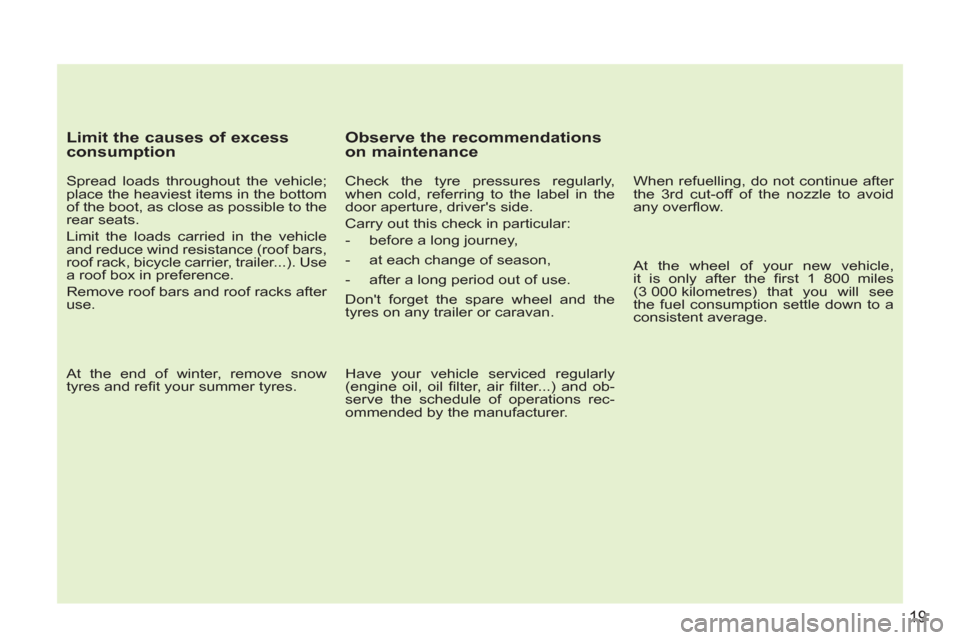
19
Limit the causes of excess
consumption
Spread loads throughout the vehicle;
place the heaviest items in the bottom
of the boot, as close as possible to the
rear seats.
Limit the loads carried in the vehicle
and reduce wind resistance (roof bars,
roof rack, bicycle carrier, trailer...). Use
a roof box in preference.
Remove roof bars and roof racks after
use.
At the end of winter, remove snow
tyres and refi t your summer tyres.
Observe the recommendations
on maintenance
Check the tyre pressures regularly,
when cold, referring to the label in the
door aperture, driver's side.
Carry out this check in particular:
- before a long journey,
- at each change of season,
- after a long period out of use.
Don't forget the spare wheel and the
tyres on any trailer or caravan.
Have your vehicle serviced regularly
(engine oil, oil fi lter, air fi lter...) and ob-
serve the schedule of operations rec-
ommended by the manufacturer.
When refuelling, do not continue after
the 3 rd cut-off of the nozzle to avoid
any overfl ow.
At the wheel of your new vehicle,
it is only after the fi rst 1 800 miles
(3 000 kilometres) that you will see
the fuel consumption settle down to a
consistent average.
Page 26 of 224
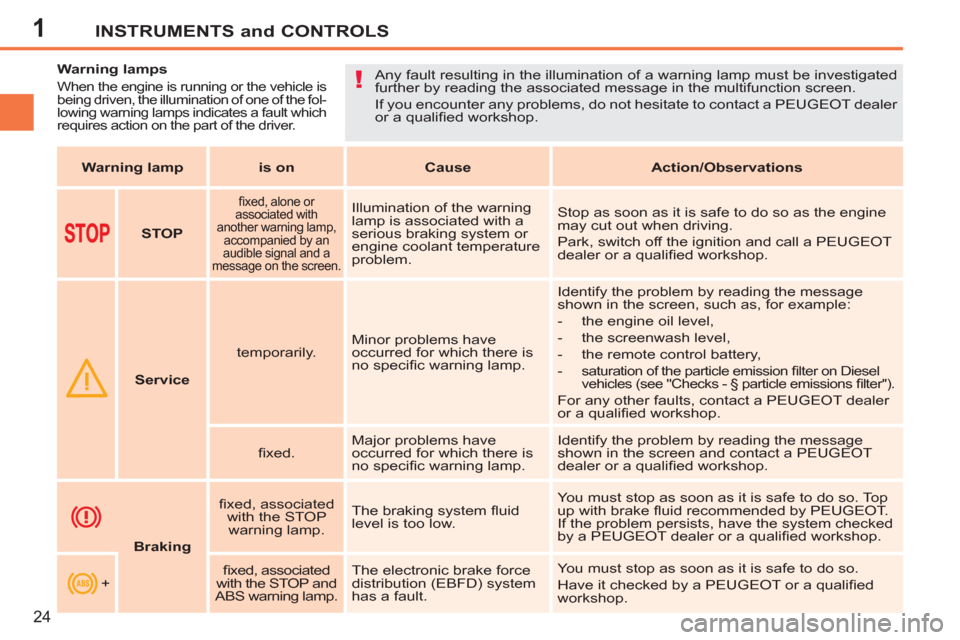
1
!
INSTRUMENTS and CONTROLS
24
Warning lamps
When the engine is running or the vehicle is
being driven, the illumination of one of the fol-
lowing warning lamps indicates a fault which
requires action on the part of the driver. Any fault resulting in the illumination of a warning lamp must be investigated
further by reading the associated message in the multifunction screen.
If you encounter any problems, do not hesitate to contact a PEUGEOT dealer
or a qualifi ed workshop.
Warning lamp
is on
Cause
Action/Observations
STOP
fi xed, alone or
associated with
another warning lamp,
accompanied by an
audible signal and a
message on the screen.
Illumination of the warning
lamp is associated with a
serious braking system or
engine coolant temperature
problem. Stop as soon as it is safe to do so as the engine
may cut out when driving.
Park, switch off the ignition and call a PEUGEOT
dealer or a qualifi ed workshop.
Service
temporarily. Minor problems have
occurred for which there is
no specifi c warning lamp. Identify the problem by reading the message
shown in the screen, such as, for example:
- the engine oil level,
- the screenwash level,
- the remote control battery,
-
saturation of the particle emission fi lter on Diesel
vehicles (see "Checks - § particle emissions fi lter").
For any other faults, contact a PEUGEOT dealer
or a qualifi ed workshop.
fi xed. Major problems have
occurred for which there is
no specifi c warning lamp. Identify the problem by reading the message
shown in the screen and contact a PEUGEOT
dealer or a qualifi ed workshop.
Braking
fi xed, associated
with the STOP
warning lamp. The braking system fl uid
level is too low. You must stop as soon as it is safe to do so. Top
up with brake fl uid recommended by PEUGEOT.
If the problem persists, have the system checked
by a PEUGEOT dealer or a qualifi ed workshop.
+
fi xed, associated
with the STOP and
ABS warning lamp. The electronic brake force
distribution (EBFD) system
has a fault. You must stop as soon as it is safe to do so.
Have it checked by a PEUGEOT or a qualifi ed
workshop.
Page 27 of 224
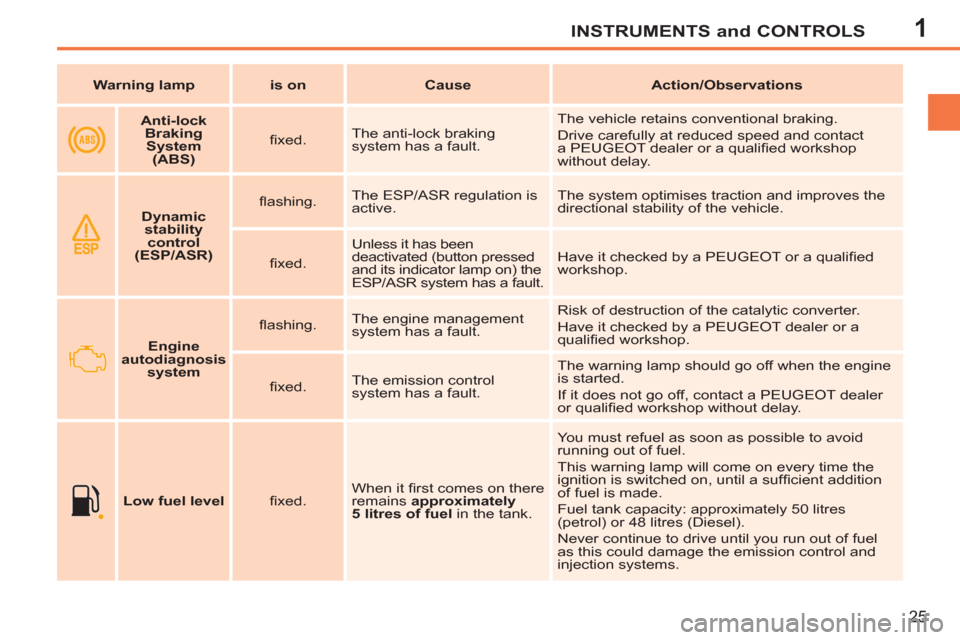
1INSTRUMENTS and CONTROLS
25
Warning lamp
is on
Cause
Action/Observations
Anti-lock
Braking
System
(ABS)
fi xed. The anti-lock braking
system has a fault. The vehicle retains conventional braking.
Drive carefully at reduced speed and contact
a PEUGEOT dealer or a qualifi ed workshop
without delay.
Dynamic
stability
control
(ESP/ASR)
fl ashing. The ESP/ASR regulation is
active. The system optimises traction and improves the
directional stability of the vehicle.
fi xed. Unless it has been
deactivated (button pressed
and its indicator lamp on) the
ESP/ASR system has a fault. Have it checked by a PEUGEOT or a qualifi ed
workshop.
Engine
autodiagnosis
system
fl ashing. The engine management
system has a fault. Risk of destruction of the catalytic converter.
Have it checked by a PEUGEOT dealer or a
qualifi ed workshop.
fi xed. The emission control
system has a fault. The warning lamp should go off when the engine
is started.
If it does not go off, contact a PEUGEOT dealer
or qualifi ed workshop without delay.
Low fuel level
fi xed. When it fi
rst comes on there
remains approximately
5 litres of
fuel
in the tank. You must refuel as soon as possible to avoid
running out of fuel.
This warning lamp will come on every time the
ignition is switched on, until a suffi cient addition
of fuel is made.
Fuel tank capacity: approximately 50 litres
(petrol) or 48 litres (Diesel).
Never continue to drive until you run out of fuel
as this could damage the emission control and
injection systems.
Page 29 of 224
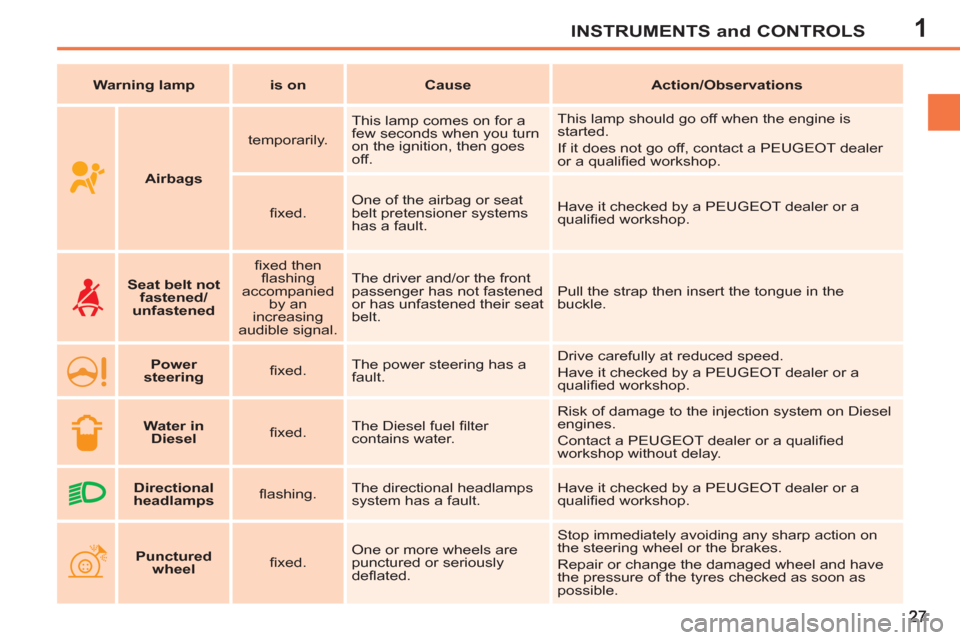
1INSTRUMENTS and CONTROLS
Warning lamp
is on
Cause
Action/Observations
Airbags
temporarily. This lamp comes on for a
few seconds when you turn
on the ignition, then goes
off. This lamp should go off when the engine is
started.
If it does not go off, contact a PEUGEOT dealer
or a qualifi ed workshop.
fi xed. One of the airbag or seat
belt pretensioner systems
has a fault. Have it checked by a PEUGEOT dealer or a
qualifi ed workshop.
Seat belt not
fastened/
unfastened
fi xed then
fl ashing
accompanied
by an
increasing
audible signal. The driver and/or the front
passenger has not fastened
or has unfastened their seat
belt. Pull the strap then insert the tongue in the
buckle.
Power
steering
fi xed. The power steering has a
fault. Drive carefully at reduced speed.
Have it checked by a PEUGEOT dealer or a
qualifi ed workshop.
Water in
Diesel
fi xed. The Diesel fuel fi lter
contains water. Risk of damage to the injection system on Diesel
engines.
Contact a PEUGEOT dealer or a qualifi ed
workshop without delay.
Directional
headlamps
fl ashing. The directional headlamps
system has a fault. Have it checked by a PEUGEOT dealer or a
qualifi ed workshop.
Punctured
wheel
fi xed. One or more wheels are
punctured or seriously
defl ated. Stop immediately avoiding any sharp action on
the steering wheel or the brakes.
Repair or change the damaged wheel and have
the pressure of the tyres checked as soon as
possible.
Page 32 of 224
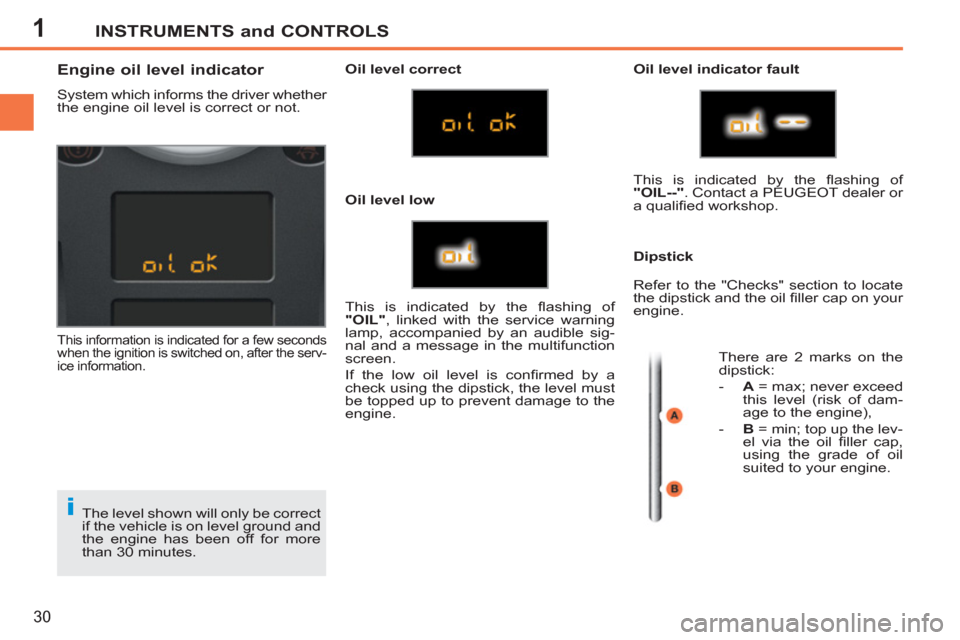
1
i
INSTRUMENTS and CONTROLS
30
The level shown will only be correct
if the vehicle is on level ground and
the engine has been off for more
than 30 minutes.
Engine oil level indicator
System which informs the driver whether
the engine oil level is correct or not.
This information is indicated for a few seconds
when the ignition is switched on, after the serv-
ice information.
Oil level correct
Oil level low
Oil level indicator fault
Dipstick
This is indicated by the fl ashing of
"OIL"
, linked with the service warning
lamp, accompanied by an audible sig-
nal and a message in the multifunction
screen.
If the low oil level is confi rmed by a
check using the dipstick, the level must
be topped up to prevent damage to the
engine. This is indicated by the fl ashing of
"OIL--"
. Contact a PEUGEOT dealer or
a qualifi ed workshop.
Refer to the "Checks" section to locate
the dipstick and the oil fi ller cap on your
engine.
There are 2 marks on the
dipstick:
- A
= max; never exceed
this level (risk of dam-
age to the engine),
- B
= min; top up the lev-
el via the oil fi ller cap,
using the grade of oil
suited to your engine.
Page 48 of 224
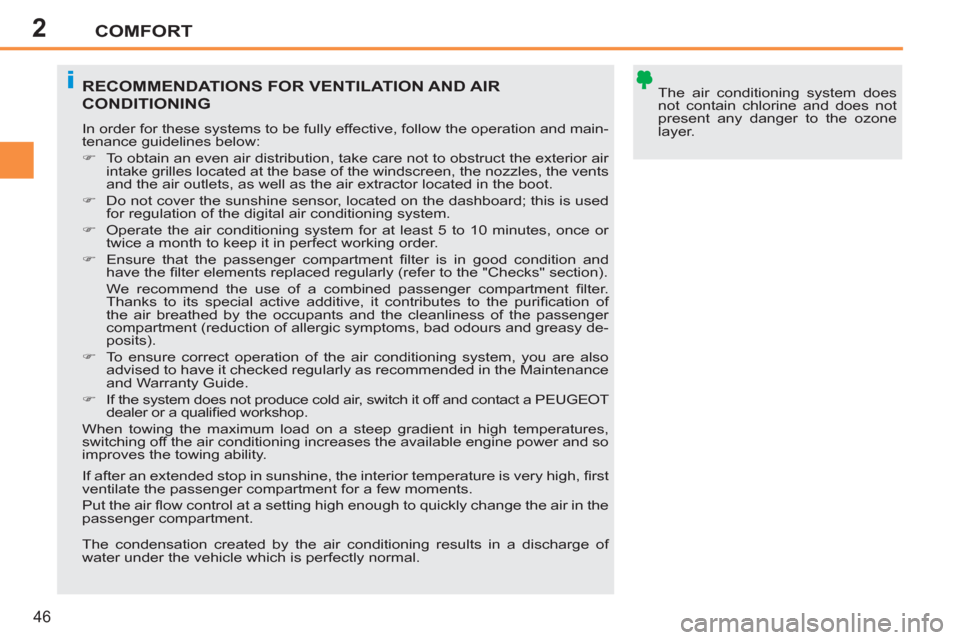
2
i
COMFORT
46
The air conditioning system does
not contain chlorine and does not
present any danger to the ozone
layer. RECOMMENDATIONS FOR VENTILATION AND AIR
CONDITIONING
In order for these systems to be fully effective, follow the operation and main-
tenance guidelines below:
�)
To obtain an even air distribution, take care not to obstruct the exterior air
intake grilles located at the base of the windscreen, the nozzles, the vents
and the air outlets, as well as the air extractor located in the boot.
�)
Do not cover the sunshine sensor, located on the dashboard; this is used
for regulation of the digital air conditioning system.
�)
Operate the air conditioning system for at least 5 to 10 minutes, once or
twice a month to keep it in perfect working order.
�)
Ensure that the passenger compartment fi lter is in good condition and
have the fi lter elements replaced regularly (refer to the "Checks" section).
We recommend the use of a combined passenger compartment fi lter.
Thanks to its special active additive, it contributes to the purifi cation of
the air breathed by the occupants and the cleanliness of the passenger
compartment (reduction of allergic symptoms, bad odours and greasy de-
posits).
�)
To ensure correct operation of the air conditioning system, you are also
advised to have it checked regularly as recommended in the Maintenance
and Warranty Guide.
�)
If the system does not produce cold air, switch it off and contact a PEUGEOT
dealer or a qualifi ed workshop.
When towing the maximum load on a steep gradient in high temperatures,
switching off the air conditioning increases the available engine power and so
improves the towing ability.
If after an extended stop in sunshine, the interior temperature is very high, fi rst
ventilate the passenger compartment for a few moments.
Put the air fl ow control at a setting high enough to quickly change the air in the
passenger compartment.
The condensation created by the air conditioning results in a discharge of
water under the vehicle which is perfectly normal.
Page 56 of 224

2
!i!
COMFORT
54
REAR SEATS
Fixed two-seat bench fi tted with roll-
over bars to ensure your protection
should the vehicle roll over.
Following an accident, have the roll-
over bars checked by a PEUGEOT
dealer. The command for activation of
heating of the seat(s) remains
memorised for two minutes after
the ignition has been switched off.
6. Heated seats switch
With the engine running, the front seats
can be heated separately.
�)
Use the adjustment dial, placed on
the side of each front seat, to switch
on and select the level of heating re-
quired:
0
: Off.
1
: Low.
2
: Medium.
3
: High
STEERING WHEEL ADJUSTMENT
�)
When stationary
, pull the con-
trol lever to release the adjustment
mechanism.
�)
Adjust the height and reach to suit
your driving position.
�)
Push the control lever to lock the ad-
justment mechanism.
As a safety precaution, these op-
erations should only be carried out
while the vehicle is stationary.
Page 70 of 224
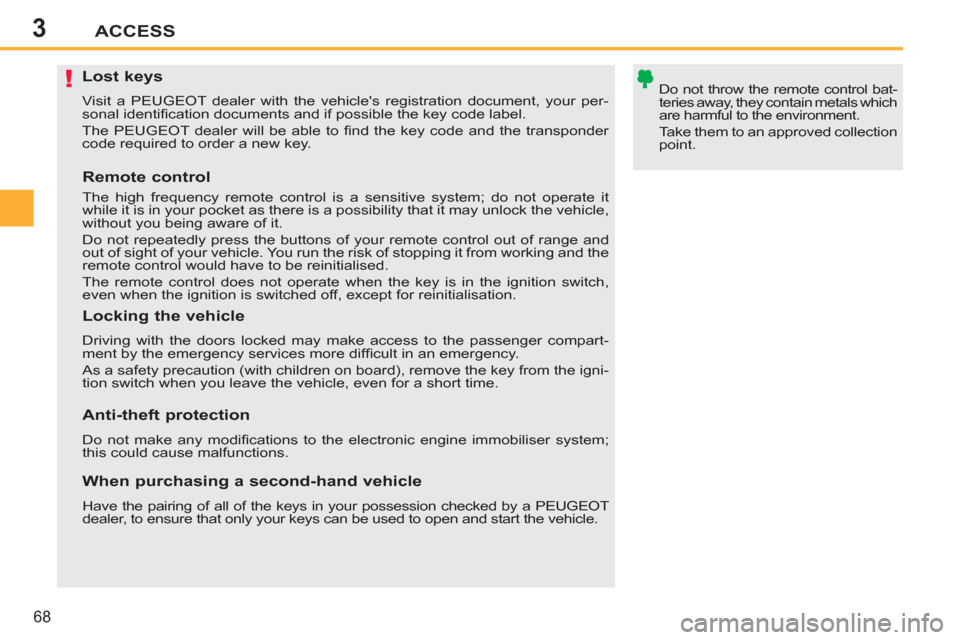
3
!
ACCESS
68
Lost keys
Visit a PEUGEOT dealer with the vehicle's registration document, your per-
sonal identifi cation documents and if possible the key code label.
The PEUGEOT dealer will be able to fi nd the key code and the transponder
code required to order a new key.
Do not throw the remote control bat-
teries away, they contain metals which
are harmful to the environment.
Take them to an approved collection
point.
Remote control
The high frequency remote control is a sensitive system; do not operate it
while it is in your pocket as there is a possibility that it may unlock the vehicle,
without you being aware of it.
Do not repeatedly press the buttons of your remote control out of range and
out of sight of your vehicle. You run the risk of stopping it from working and the
remote control would have to be reinitialised.
The remote control does not operate when the key is in the ignition switch,
even when the ignition is switched off, except for reinitialisation.
Locking the vehicle
Driving with the doors locked may make access to the passenger compart-
ment by the emergency services more diffi cult in an emergency.
As a safety precaution (with children on board), remove the key from the igni-
tion switch when you leave the vehicle, even for a short time.
Anti-theft protection
Do not make any modifi cations to the electronic engine immobiliser system;
this could cause malfunctions.
When purchasing a second-hand vehicle
Have the pairing of all of the keys in your possession checked by a PEUGEOT
dealer, to ensure that only your keys can be used to open and start the vehicle.